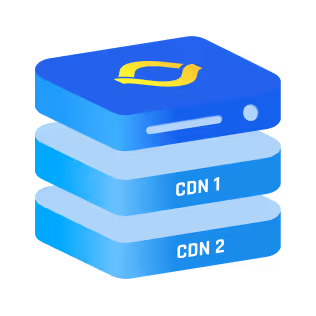If you've ever wondered how your internet requests get from your computer to a website without revealing everything about you, you’re probably talking about a forward proxy.
These tools are like a middleman between you and the internet, offering some handy features. Let’s break it all down.
What is a Forward Proxy?
A forward proxy is a server that sits between your device and the internet. Think of it as a bridge or a gatekeeper. When you make a request to visit a website, your request first goes to the forward proxy server. The proxy then forwards your request to the internet on your behalf. Once the website responds, the proxy sends that response back to you.
Here’s a simple way to imagine it: It’s like having a friend ask a question for you. Instead of people knowing it’s you asking, they think it’s your friend. This adds a layer of privacy and control.
How Does a Forward Proxy Work?
Here’s how the process flows step-by-step:
- You Make a Request
Say you want to visit a website like example.com. Instead of sending the request directly, your device sends it to the forward proxy server. - The Proxy Evaluates Your Request
The forward proxy checks if your request follows its rules. For example, if a company uses a proxy to block certain websites, your request might get denied here. - The Proxy Forwards the Request
If allowed, the proxy server sends your request to the destination website. - The Website Responds
The website sends back the data, like the webpage you’re trying to load, to the proxy. - The Proxy Delivers the Response to You
Finally, the forward proxy sends the website’s response to your device.
This simple process hides your IP address from the website. Instead, the website only sees the proxy’s IP address, not yours.
Types of Forward Proxies
Forward proxies come in several flavors, each optimized for a different blend of privacy, performance, and policy control.
Below are the most common categories you’ll see in real-world deployments.
Key Benefits of Using a Forward Proxy
Why would you use a forward proxy? Here are some of the top benefits:
- Privacy Protection
A forward proxy hides your IP address, making it harder for websites to track you. This is great for browsing the internet without leaving a digital trail. - Access to Blocked Content
If you’re in a region where certain websites are blocked, a forward proxy can bypass those restrictions by rerouting your request through a different location. - Bandwidth Savings
Forward proxies can cache (store) frequently visited websites. If multiple users request the same site, the proxy can serve a cached version, saving bandwidth. - Improved Security
Organizations often use forward proxies to filter traffic. For example, they can block harmful websites, limit access to non-work-related sites, or enforce company policies. - Anonymity for Testing
Developers and cybersecurity professionals use forward proxies to test websites or apps anonymously without revealing their real IP addresses.
How to Set Up a Forward Proxy
Setting up a forward proxy may sound technical, but it’s a straightforward process if you follow these steps:
- Choose a Proxy Software or Service
Start by selecting a forward proxy tool or software. Popular options include Squid, Apache, or Nginx. Some cloud services also offer easy proxy setups. - Install the Software
Download and install the chosen proxy software on a server or device that will act as the proxy. - Configure the Proxy Settingssome text
- Open the configuration file for the software. For example, with Squid, this is usually a file called squid.conf.
- Define rules such as which devices can use the proxy, the ports to be used, and access controls for blocked or allowed websites.
- Enable Caching (Optional)
To save bandwidth and improve performance, configure proxy caching. Most proxy software includes settings to store copies of frequently visited sites. - Test the Proxy Server
Ensure the proxy is working by setting up a device to route traffic through it. Change the network settings on your computer or browser to use the proxy server’s IP address and port. - Secure Your Proxy
Add authentication to limit who can use the proxy. You can also set up encryption (like HTTPS) to protect data traveling through the proxy. - Monitor and Maintain
Regularly check logs to ensure the proxy is working as intended. Update the software to patch vulnerabilities and improve performance.
Once your forward proxy is set up, you can use it to manage traffic, improve privacy, and control access to the internet.
{{cool-component}}
Common Use Cases for Forward Proxies
Forward proxies aren’t just for tech-savvy people. They’re used in many everyday situations:
- Schools and Workplaces
Schools and companies use forward proxies to control what content you can access. They might block social media or streaming sites to keep people focused. - Streaming and Gaming
Want to watch a show or play a game that’s unavailable in your country? A forward proxy can make it look like you’re browsing from a different location. - Businesses Protecting Data
Forward proxies can filter out malicious websites, reducing the risk of downloading viruses or falling for phishing scams. - Web Scraping and Data Collection
Companies and researchers use forward proxies to gather data from websites without revealing their identity or IP address. - Personal Privacy
For individuals who want to keep their browsing habits private, forward proxies act as a shield, hiding their IP address and location.
Forward Proxy vs. Reverse Proxy: Key Differences
It’s easy to confuse a forward proxy with a reverse proxy, but they serve different purposes. Let’s break it down.
In simple terms, a forward proxy works for you to interact with the internet while staying anonymous, filtering content, or accessing restricted resources. It’s positioned at the edge of your network, managing outbound traffic.
A reverse proxy, on the other hand, sits in front of web servers and manages inbound traffic. It receives requests on behalf of one or more backend servers, decides where to send those requests, and then returns the response.
This setup allows websites to scale better, hide internal infrastructure, balance load, and apply security policies like IP filtering and rate limiting.
If a forward proxy is your personal internet gatekeeper, a reverse proxy is a website’s protective bouncer.
Additional Benefits of Forward Proxies
Forward proxies offer even more than what’s typically discussed. For example:
- Content Filtering
Parents can use forward proxies to block inappropriate content for kids. - Reducing Latency
Proxies close to your location can speed up internet requests by caching popular sites. - Control Over Internet Usage
Organizations can monitor internet activity and even set limits on data usage.
Final Thoughts
A forward proxy is like your personal internet assistant. It keeps your browsing private, helps you access restricted content, and even saves bandwidth.
The next time you think about staying anonymous online or bypassing restrictions, remember the handy forward proxy server! It’s your ticket to a safer and more flexible internet experience.
FAQs
What is the main function of a forward proxy server?
A forward proxy server acts as an intermediary between users and the internet. Its main function is to forward client requests to the web while masking the client’s IP address. This setup helps enforce network policies, cache content, and control access, explaining how forward proxies work to manage outgoing internet traffic.
How does a forward proxy improve privacy and security for users?
Forward proxies hide users' real IP addresses and can encrypt outbound traffic, reducing the chances of tracking or interception. This means users gain privacy by appearing anonymous to destination servers, showcasing one of the major benefits of forward proxies in safeguarding personal and corporate data.
What are the differences between forward proxy and reverse proxy?
In the forward proxy vs reverse proxy comparison, a forward proxy serves clients trying to reach the internet, while a reverse proxy serves external users trying to reach a web server. Forward proxies manage outbound traffic; reverse proxies manage inbound requests, providing load balancing and DDoS protection.
Can a forward proxy be used to access geo-restricted content?
Yes, a forward proxy can route traffic through servers in other countries, allowing users to bypass geo-blocks. By masking your location, forward proxies work around content restrictions on platforms like streaming services or news sites, making this one of the practical benefits of forward proxies.
What are the risks or limitations of using forward proxies?
While useful, forward proxies have limitations. Misconfigured proxies can leak data or introduce latency. Some websites detect and block proxy traffic. Also, relying on unsecured public proxies can expose you to malicious intermediaries. It's important to understand how forward proxies work to mitigate these risks effectively.



.png)
.png)
.png)






